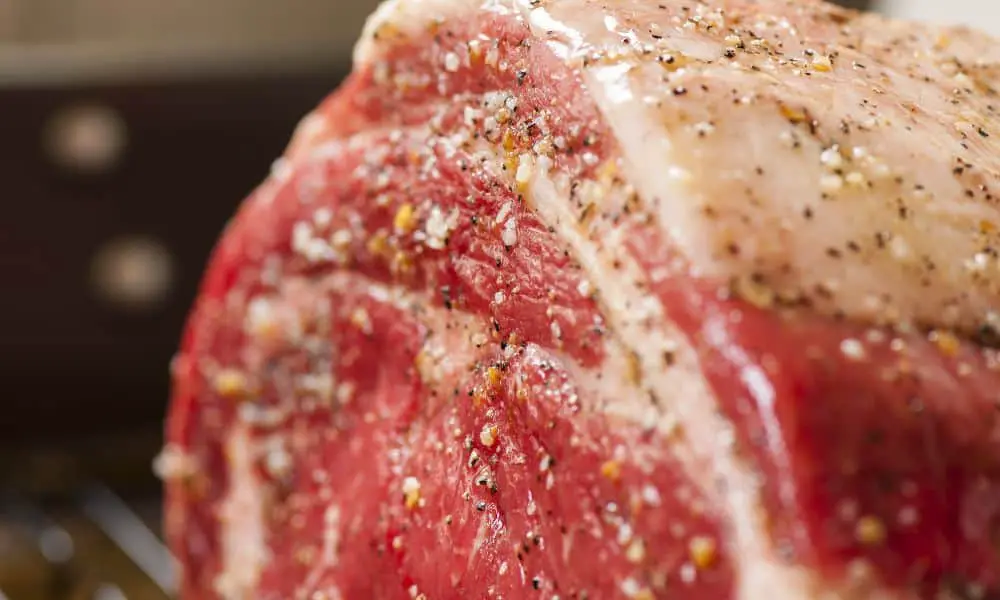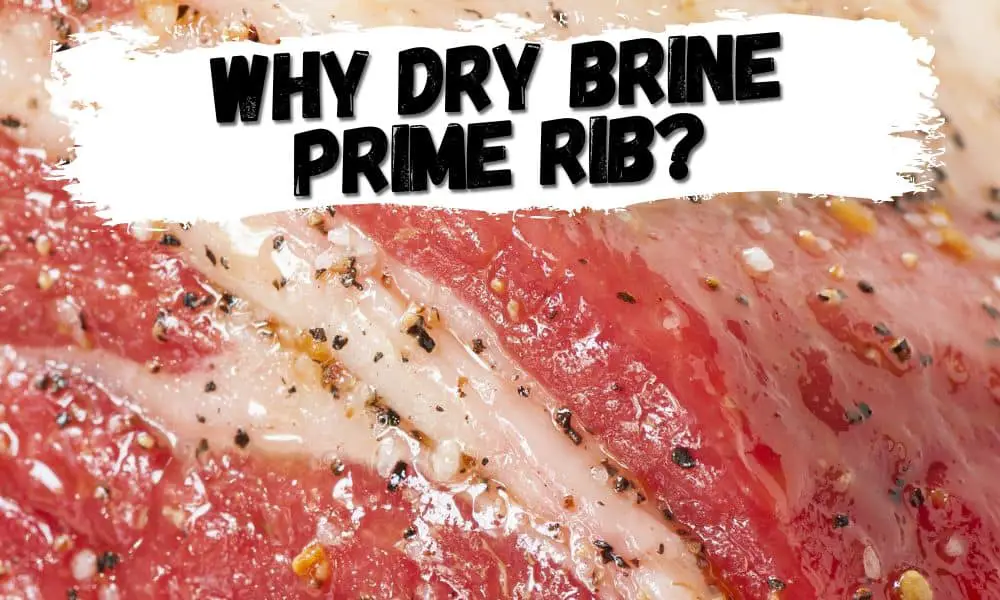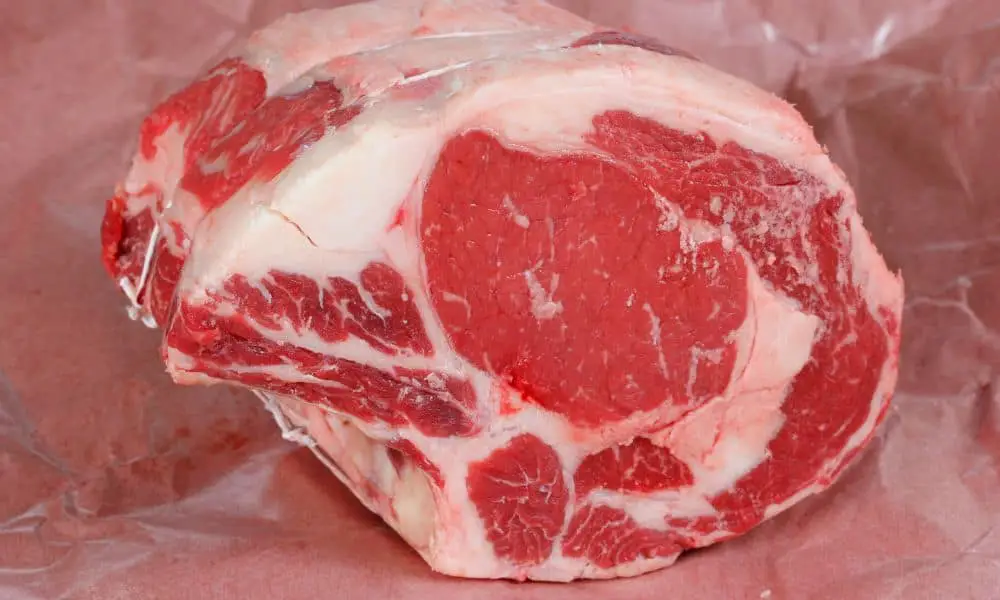When’s the last time you’ve made a meal and it’s truly knocked the socks off of your guests?
If it’s been far too long, then you’re just in luck because a perfectly executed dry-brined prime rib is one of the most reliable sock knocker-offers out there.
Really though, there’s no question in my mind that dry brining prime rib is the way to a tender, moist, and magnifico centerpiece.
Here’s why you should dry brine your prime rib and exactly how to do it.

For those that prefer cookin’ over lookin’, here’s the short and sweet on why you should stop what you’re doing and start dry brining your prime rib.
Really though, dry brining a prime rib will ensure it retains as much moisture as possible over the cooking process, gives the meat an added tenderness, AND helps the meat develop a richer flavor.
That’s a hat-trick ladies and gentlemen.
So go and start dry brining your prime rib now and come back to start salivating as you learn exactly how it’s going to take your prime rib to the next level.
A Salty Love Story: What Does Dry Brining Prime Rib Do?

At first, the very idea of bathing prime rib in salt sounds counter-intuitive. You might even think it’ll draw out moisture, dry out the meat, and make it way too salty.
It’s funny though, because it pretty much does exactly the opposite.
Dry brining prime rib effectively:
- Locks in the moisture
- Starts tenderizing the meat
- Brings out the best natural flavors
Here’s how the dry brining process does it
Locks In That Juicy Goodness
The biggest plot twist in the culinary world: adding a salt brine to beef actually makes the cooked result juicer, not the other way around.
Basically when you dry brine red meat, the salt will draw moisture from the meat to the surface. Over time, this salty juiciness, the brine, is then reabsorbed into the meat.
Once absorbed the salt works some magic on the proteins, allowing the meat to retain a significantly higher amount of it’s moisture as it cooks.
Seriouseats explains this process wonderfully.
Tenderness For Days
The salty brine effect also works wonders with the tenderness. The salt actually begins to “dissolve” the proteins which in turn starts to tenderize the meat.
Tenderness for days, weeks even.
Flavor Overload
There’s no denying the pivotal difference that a bit of salt and pep’ can make on a hunk of meat.
With dry brining, you’re essentially taking this same principle, but applying it to the entire piece of meat from the inside to the outside.
During the dry brining process the salty brine permeates into the meat and evenly distributes itself through a process called diffusion: moving from places of high concentration to low concentration.
Dry Brining Prime Rib: Directions To Flavortown
By now you should be part of the movement that believes dry brining is the way to go with prepping a prime rib.
Here’s how to make and apply a simple brine rub that’ll do exactly what it needs to.
Choosing The Best Eligible Meat Bachelor

Find yourself a nice-looking prime rib. As much marbling as possible and an even shape as possible.
Boned or boneless, that’s up to you, but bone-in prime rib almost always wins from a flavor and juiciness perspective.
If you plan to serve prime rib as the main course, you’ll want to account for at least 1 pound of raw prime rib per person.
Salting Time: Making The Brine
Some people use sea salt, some people use rock salt. Although I think kosher salt is king, honestly you can use any salt.
Although I’ve seen people going pretty crazy with the amount of salt they use, you really only need about a teaspoon of salt per pound of prime rib.
You can optionally add other herbs or spices to the mix, though it will really only be the salt that works it’s brining magic.
When It’s Time To Dry Brine
When it’s time to dry brine your prime rib, don’t overthink it. It’s really not rocket science and you really can’t go wrong.
Just relax, remember your training, and evenly coat the prime rib in the salt, being sure to cover every side.
How Long To Wait While Dry Brining Prime Rib?
To feel the full effect of the brining process, you’ll want to wait at least 8 hours or overnight. You’ll get 80% of all the goodness from the brining process this way, without becoming too impatient.
If you have the luxury of time, then you can choose to leave it on for 24-48 hours to harness the full effects of the dry brining process.
After applying the dry salt brine, cover your prime rib in something like baking paper (loosely) and it into the refrigerator for your desired amount of time.
Can You Dry Brine Prime Rib Too Long?
The sweet spot for brining is between about 8 and 48 hours, but it is possible to over brine your prime rib.
Although people’s first thoughts go to “perhaps it was dry brined too long”, it’s more often than note a combination of:
- Adding too much salt to the original brine
- Leaving your prime rib brining for more than 48 hours
- Adding MORE salt and seasonings before or after the cook
Prime rib CAN take on a lot of salt and still taste incredibly rich and beefy, but there is a limit!
The best advice I can give to avoiding over-brined prime rib is to limit the amount of additional seasoning you add after the brining process.
Wrap Up: Dry Brining Prime Rib For The Win
Hold on a minute, I’m just putting my recently knocked-off socks back on my feet.
You see, I just had the most melt-in-your-mouth moist morsel of prime rib.
The secret? The dry brining process which takes the tenderness, juiciness, and flavor to new heights.
If you don’t believe me then you’ve just got to try it for yourself!

